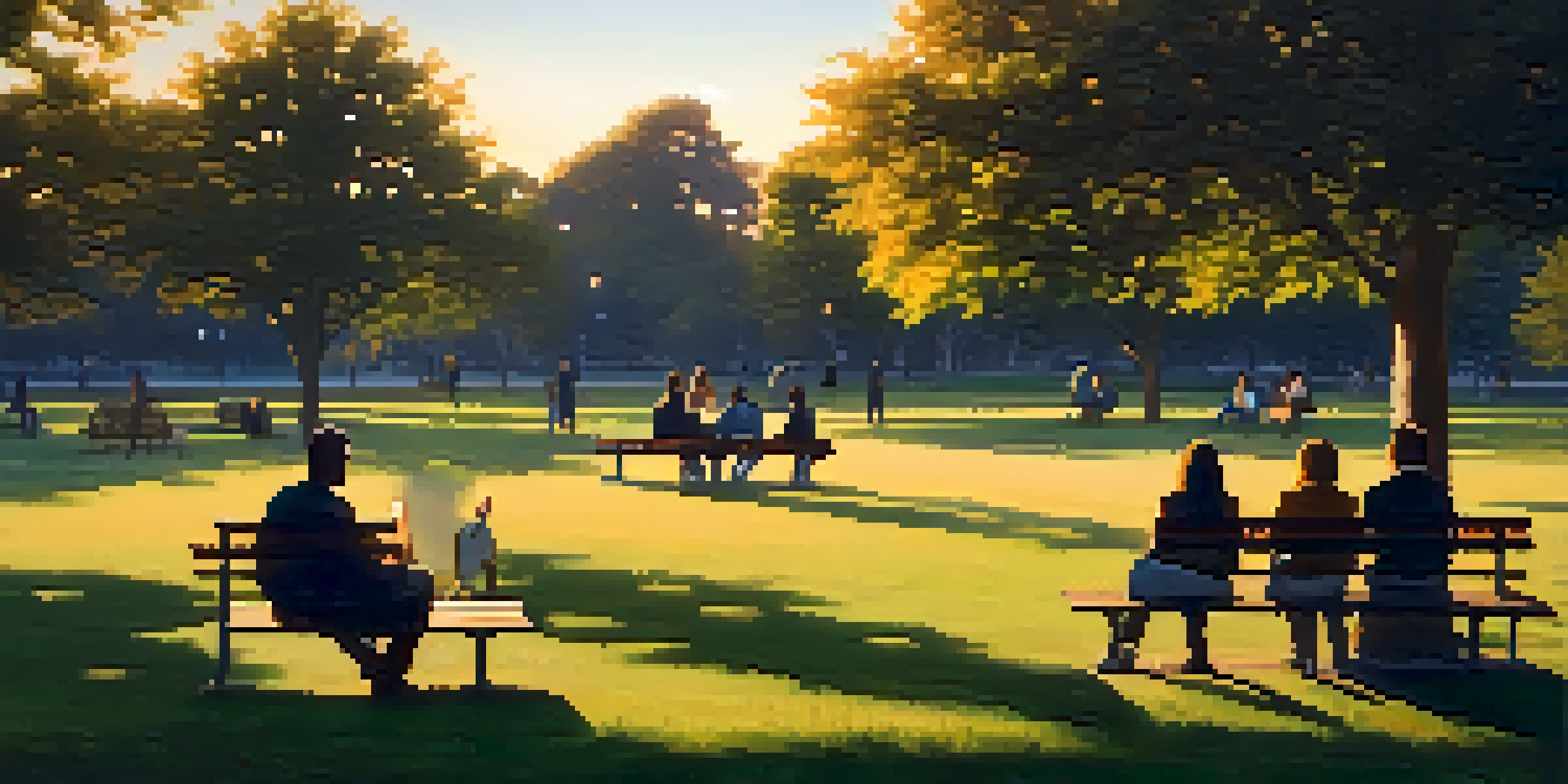Stand Your Ground Laws: Understanding Their Impact

What Are Stand Your Ground Laws and Their Purpose?
Stand Your Ground laws allow individuals to use force, including deadly force, in self-defense without the duty to retreat. The main idea is to empower citizens to protect themselves when they feel threatened, particularly in situations where retreat isn't safely possible. This legal framework is rooted in the belief that individuals should not be forced to flee from danger, thereby promoting personal safety and empowerment.
The law is not a shield for those who seek confrontation; it is a safeguard for those who are truly threatened.
These laws vary significantly by state, with some jurisdictions embracing them more broadly than others. For instance, Florida's law, which gained national attention after the Trayvon Martin case, permits individuals to act in self-defense without retreating, even in public spaces. Understanding the nuances of these laws is essential for both citizens and law enforcement, as they can influence real-life encounters and judicial outcomes.
While proponents argue that these laws enhance personal safety, critics raise concerns about potential misuse and escalation of violence. The ongoing debate highlights the complexities surrounding self-defense, societal safety, and the legal system's role in mediating these issues.
Historical Development of Stand Your Ground Laws
The origins of Stand Your Ground laws can be traced back to the traditional 'castle doctrine,' which allows individuals to use force in their homes. Over time, this concept expanded into public spaces, leading to the modern interpretations we see today. This evolution reflects changing societal views on self-defense and personal safety, particularly in the wake of rising crime rates during the late 20th century.

In the early 2000s, several states began enacting laws that explicitly removed the duty to retreat, influenced by advocacy groups and a growing sentiment for self-defense rights. By 2023, over 30 states had adopted some form of Stand Your Ground law, showcasing a significant shift in American legal standards surrounding self-defense. This widespread adoption has sparked both support and criticism, as the implications of these laws continue to unfold.
Understanding Stand Your Ground Laws
These laws empower individuals to use force in self-defense without the duty to retreat, varying significantly by state.
The historical context is crucial in understanding the current landscape of self-defense laws. As these statutes evolve, they raise important questions about the balance between individual rights and community safety, making historical insight vital for informed discussions.
Key Legal Principles Behind Stand Your Ground Laws
At the core of Stand Your Ground laws is the principle of self-defense, which asserts that individuals have the right to protect themselves from imminent harm. Legal definitions of 'imminent' vary, leading to different interpretations in courts. This variability can create confusion for individuals who rely on these laws in critical moments, emphasizing the need for clear understanding and guidance.
Self-defense is not only a right but a responsibility to protect oneself and others from harm.
Another important legal principle is proportionality, which requires that the response to a threat be reasonable and not excessive. However, the application of this principle can be subjective, often leading to contentious court cases where juries must determine what was reasonable in the heat of the moment. This subjectivity is one reason why Stand Your Ground laws are often at the center of public discourse and legal scrutiny.
Moreover, the presence of 'reasonable belief'—the idea that a person must believe they are in immediate danger—can complicate cases. This belief is assessed based on the perspective of the person facing the threat, which can lead to divergent outcomes in similar cases based solely on differing perceptions.
Impact of Stand Your Ground Laws on Crime Rates
The relationship between Stand Your Ground laws and crime rates is a hotly debated topic. Some studies suggest that these laws may deter crime by empowering law-abiding citizens to defend themselves, potentially leading to a decrease in violent crime. In contrast, other research indicates a correlation between these laws and increased rates of homicide, as they may embolden individuals to engage in violent confrontations.
Analyzing data from states with Stand Your Ground laws reveals mixed results, further complicating the narrative. For instance, while some regions report a decline in certain crimes, others have seen an uptick in incidents involving firearms. This inconsistency underscores the notion that the laws' impacts can vary widely based on local culture, law enforcement practices, and community dynamics.
Debate Over Crime Rates Impact
The relationship between Stand Your Ground laws and crime rates is complex, with studies showing mixed results on their effects.
Ultimately, understanding the true impact of these laws requires a nuanced approach, considering various social, economic, and legal factors. The conversation surrounding crime rates and Stand Your Ground laws remains ongoing, with new research constantly emerging to inform policymakers and citizens alike.
Public Perception and Controversies Surrounding Stand Your Ground
Public perception of Stand Your Ground laws is deeply polarized, often influenced by high-profile cases that have captured national attention. Incidents involving the use of these laws, such as the Trayvon Martin case, have sparked widespread protests and calls for reform. These events highlight the emotional weight and societal implications of self-defense laws, prompting many to question their effectiveness and fairness.
Critics argue that Stand Your Ground laws disproportionately affect marginalized communities, leading to racial disparities in their application. Studies have shown that these laws may result in different legal outcomes based on race, raising critical concerns about justice and equality. This controversy adds another layer to the discussion, as advocates for reform push for changes to address these disparities.
On the other hand, supporters maintain that these laws enhance personal freedom and self-protection. They argue that individuals should not face legal repercussions for defending themselves against threats. This tug-of-war between perspectives reflects broader societal issues, making the debate about Stand Your Ground laws a microcosm of larger discussions surrounding race, justice, and individual rights.
Stand Your Ground Laws: Legal Challenges and Reforms
As Stand Your Ground laws have gained prominence, they have also faced numerous legal challenges and calls for reform. Critics often argue that the laws can lead to unjust outcomes, particularly in cases involving racial dynamics or ambiguous circumstances. These challenges have led courts to reevaluate the application of these laws, emphasizing the need for clarity and fairness in their interpretation.
Some states have responded to public outcry by proposing reforms aimed at addressing concerns about misuse. These proposals may include clearer definitions of 'reasonable belief' and 'imminent danger' to reduce ambiguity. As discussions around reform continue, it's essential for lawmakers to engage with communities and experts to ensure that any changes reflect the needs and concerns of the public.
Public Perception and Racial Disparities
Stand Your Ground laws evoke polarized views, with concerns about their impact on marginalized communities and racial justice.
Legal challenges to Stand Your Ground laws often highlight the tension between individual rights and societal safety. Balancing these interests is no easy task, but ongoing dialogue among stakeholders can lead to more equitable and just outcomes for all.
The Future of Stand Your Ground Laws in America
Looking ahead, the future of Stand Your Ground laws in America remains uncertain, as public opinion continues to evolve. As more incidents involving these laws come to light, communities are increasingly demanding accountability and transparency. This shift could prompt lawmakers to reconsider the legal frameworks surrounding self-defense, leading to potential changes in the coming years.
Moreover, advancements in technology and social media are playing a role in shaping public discourse. Footage from smartphones and social media platforms can bring incidents to the forefront, influencing how society perceives these laws and their implications. This increased visibility can fuel advocacy for reform, pushing lawmakers to take action in response to public sentiment.

Ultimately, the trajectory of Stand Your Ground laws will depend on ongoing discussions among stakeholders, including policymakers, legal experts, and community members. As society grapples with the complexities of self-defense, the conversations surrounding these laws will likely continue to evolve, impacting the legal landscape for generations to come.